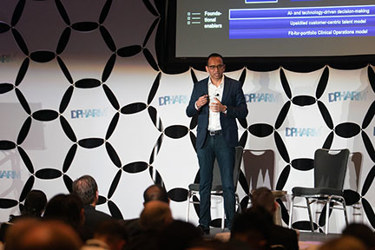Clinical Trials At A Crossroads

By Dan Schell, Chief Editor, Clinical Leader

At the 2025 DPHARM conference, I watched Gaurav Agrawal of McKinsey & Company deliver a brisk but sobering talk on where clinical trials are headed and what’s holding the industry back. His central message: Science is advancing faster than the system built to deliver it, and unless the industry rethinks its models for patient access, partnerships, and technology adoption, the next decade will look a lot like the last one — only more congested.
Great.
Agrawal began with the current landscape, noting drug development is exploding across TAs such as cardiovascular and metabolic diseases, adding to the already crowded oncology field. But the number of active trials hasn’t translated into improved success rates. Despite all the innovation in mechanisms of action and trial design, phase transition attrition rates remain stubbornly flat. The reason, probably to no one’s surprise, lies in the operational gridlock at the site level.
Trials now require more sites per patient than they did a decade ago, yet many of those sites never enroll a single participant. Agrawal referred to these as “silent sites” — a symptom of both site saturation and inefficient feasibility planning. With too many sponsors chasing the same patient populations, sites are overwhelmed and underproductive. Meanwhile, regulators are introducing new geographic participation requirements, such as Germany’s stipulation that 5% of global trial patients come from within its borders, forcing sponsors to rethink where and how they run studies.
Global Complexity Meets Local Constraints
Geopolitical shifts are adding another layer of complexity. Agrawal pointed out that restrictions on moving samples and data across borders are colliding with sponsors’ ambitions to globalize development. In some countries, participation thresholds are flexible suggestions; in others, like Germany, they now affect reimbursement tiers.
Emerging markets such as China present both opportunity and risk. Sponsors see them as ideal for fast proof-of-concept studies, but inconsistent data governance and geopolitical tension threaten the flow of global collaboration. In short, Agrawal said, the balance between global scalability and local compliance is becoming harder to maintain — and sponsors need new strategies for distributed, resilient operations.
AI And The Human Bottleneck
Agrawal was direct about AI: It’s not the panacea many hope for, but it’s finally proving its worth in specific use cases. He highlighted McKinsey’s work with pharma companies using AI to select optimal sites and countries based on historic enrollment data and site performance; the same kind of applications discussed in McKinsey’s “Unlocking Peak Operational Performance in Clinical Development with Artificial Intelligence”.
“We are starting to see small proofs of concept actually delivering value,” he said. “The key is how do we scale this?” Agrawal emphasized that AI can supplement human expertise rather than replace it, but success will depend on embedding these tools into daily operations without overwhelming already burdened teams.
Scaling AI, he noted, will require more than technology; it will require a shift in mindset. Sponsors must blend automation with what he called “human-centric power,” ensuring that digital transformation serves people, not the other way around. McKinsey’s “Accelerating Clinical Trials to Improve Biopharma R&D Productivity” echoes this point, emphasizing that digital advances must align with structural and cultural change to drive real gains.
A New Vision For Trials: Seamless, Strategic, And Simplified
The heart of Agrawal’s talk was a collaborative “vision for 2035” co-developed with heads of ClinOps from 20–25 pharma companies. “This is a vision that was crafted together with all of them,” he explained, “which is: How do we halve the time and serve twice the patients with better experience — better experience both for sites and for patients — over the next decade?”
He outlined four pillars for that transformation.
- First, trials must become part of a seamless care experience — integrated with everyday healthcare rather than isolated in AMCs. He cited oncology as the prime example of imbalance: 90% of cancer patients receive care in community centers, yet nearly 90% of oncology trial sites are based in AMCs. “Unless we can cover the vast majority of the patients closer to the site of care,” Agrawal said, “I think it’s going to be difficult to continue scaling this model in the industry.”
- Second, the trial ecosystem must diversify. The post-COVID push toward DCTs fizzled when the business case didn’t hold up for retail players like CVS. Still, Agrawal said, the idea of expanding the ecosystem — through community sites, virtual components, and tech-enabled vendors — remains essential.
- Third, sponsors and sites must rebuild trust. Frankly, I was surprised when he said site satisfaction was declining, and that, too often, sponsors treat sites as vendors rather than partners. I thought we were making some headway in that arena in recent years. Still, he urged companies to think “end to end,” redesigning processes around the needs of investigators and study coordinators.
- Finally, innovation in trial design must simplify, not complicate. Adaptive protocols and platform studies are proliferating, but unless they reduce the operational and patient burden, they risk adding complexity under the banner of progress.
From Proof Of Concept To Proof Of Scale
Agrawal closed with a challenge: the industry doesn’t lack technology or ambition; it lacks the ability to scale. Sponsors have pilot programs that work, from AI-driven feasibility to digital patient engagement, but most remain proofs of concept. To achieve the vision of faster, simpler, more inclusive trials, the sector must move from experimentation to execution. Easier said than done in such a risk-averse industry, but still a message that needs repeating.
“The next decade,” he concluded, “will determine whether clinical research becomes a seamless extension of healthcare — or continues as a parallel universe running at its own pace.”
